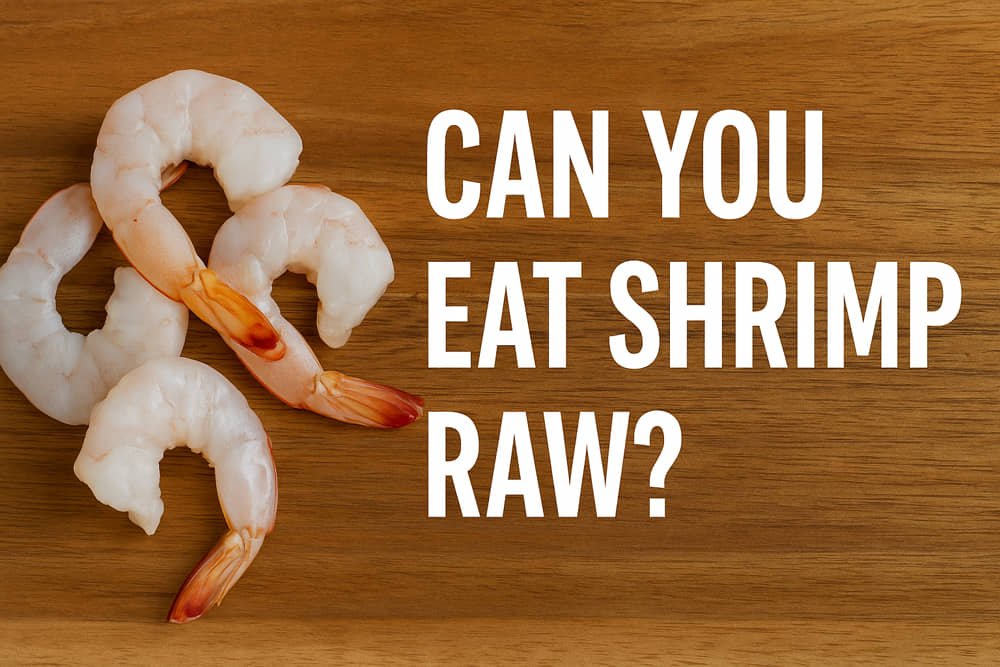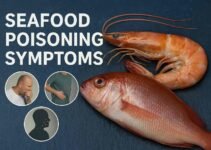Raw shrimp appears in various cuisines around the world, especially in Japanese sashimi, Peruvian ceviche, and coastal raw bars. While raw fish is widely accepted, many people are unsure whether shrimp can be consumed in the same way. The concern stems from foodborne pathogens, unclear labeling, and mixed advice online.
This article provides a factual, structured answer to the question: Can you safely eat shrimp raw? It dissects the risks, safety classifications like “sushi-grade,” storage conditions, and trusted preparation methods. By the end, you will know exactly how to assess and safely enjoy raw shrimp—or avoid it entirely if needed.
Contents
- 1 Can you safely eat shrimp raw?
- 2 What is “sushi-grade” shrimp and is it really safe to eat raw?
- 3 How should raw shrimp be handled and stored to prevent contamination?
- 4 Are there specific shrimp dishes that are traditionally served raw?
- 5 Is it safe for pregnant women or people with weakened immunity to eat raw shrimp?
- 6 How can you choose safe raw shrimp at the grocery store or fish market?
- 7 What are the symptoms of foodborne illness from raw shrimp?
- 8 How soon do symptoms appear after eating contaminated shrimp?
- 9 What should you do if you suspect shrimp-related food poisoning?
- 10 Can quick-pickling or light curing retain texture and reduce risk?
- 11 Are there cooked alternatives that mimic raw shrimp texture?
Can you safely eat shrimp raw?
Yes, you can eat shrimp raw if it has been frozen properly and sourced from a certified supplier. According to FDA guidelines, shrimp intended for raw consumption must be frozen at -4°F (-20°C) or below for at least 7 days to kill parasites. This rule applies to both wild-caught and farm-raised shrimp.
However, eating raw shrimp that hasn’t undergone proper freezing carries a high risk of foodborne illness. The most common threats include Vibrio parahaemolyticus, Salmonella, and Listeria monocytogenes, all of which thrive in uncooked shellfish.
Raw shrimp must meet two conditions to be considered safe: 1) proper deep-freezing according to FDA regulations, and 2) handling in hygienic, temperature-controlled environments from catch to consumption. Any shrimp that lacks traceable sourcing or was stored above 40°F (4°C) for extended periods is unsafe to eat raw.
What is “sushi-grade” shrimp and is it really safe to eat raw?
“Sushi-grade” is a marketing term, not a legally defined food safety standard. It suggests that the shrimp has been frozen to eliminate parasites, but the term itself is not regulated by the FDA or any governing body. Restaurants and fish markets may use “sushi-grade” to indicate high freshness and safety, but verification is essential.
Sushi-grade shrimp differs from regular shrimp in two key ways:
- It is flash-frozen immediately after harvest to preserve texture and eliminate parasites.
- It is often handled in HACCP-certified facilities, ensuring strict hygiene and cold-chain management.
Restaurants offering raw shrimp must follow freezing protocols set by the FDA. However, enforcement varies by country and establishment. Always confirm whether shrimp labeled “sushi-grade” has documentation of freezing history. Trusted vendors often provide harvest dates, catch zones, and processing details.
How should raw shrimp be handled and stored to prevent contamination?
Raw shrimp must be stored below 40°F (4°C) and consumed within 24 hours of thawing. Improper storage significantly increases the risk of bacterial growth. Shrimp is highly perishable and should never be kept at room temperature for longer than 1 hour.
The FDA recommends two freezing methods for parasite destruction:
- Freeze at -4°F (-20°C) for 7 days.
- Freeze at -31°F (-35°C) until solid, then store at -31°F for 15 hours.
Fresh raw shrimp shows these 3 signs of safety:
- Translucent flesh with no signs of graying or yellowing.
- Mild ocean-like smell, not ammonia or sulfur.
- Firm texture when touched, not slimy or mushy.
Avoid shrimp that has been thawed and refrozen, especially if the packaging lacks date stamps or freezing method details.
Are there specific shrimp dishes that are traditionally served raw?
Yes, several shrimp dishes in global cuisines are intentionally served raw for their delicate flavor and texture. The most notable example is amaebi in Japanese cuisine, also known as sweet shrimp. Amaebi is served as nigiri or sashimi, prized for its sweetness and slightly firm bite when raw. The shrimp is typically flash-frozen and consumed within hours of defrosting.
In Latin American cuisine, shrimp is commonly prepared in ceviche. However, ceviche is not technically raw—it involves marinating the shrimp in citrus juice, which denatures the proteins. This process changes the texture and color, but does not eliminate bacteria or parasites, making it less safe than fully cooked shrimp.
Another raw preparation is Goong Chae Nam Pla from Thailand, where raw shrimp is marinated briefly in fish sauce, lime juice, and garlic. While flavorful, this dish relies heavily on extremely fresh and safely frozen shrimp to minimize risk.
Only dishes using shrimp that meet strict freezing and hygiene standards should be considered safe for raw consumption.
Is it safe for pregnant women or people with weakened immunity to eat raw shrimp?
No, raw shrimp is not safe for pregnant women, children, elderly individuals, or anyone with a compromised immune system. These populations are more vulnerable to foodborne pathogens like Listeria monocytogenes, which can cause miscarriage, premature birth, or severe infection.
Pregnant women should avoid all raw shellfish, including shrimp, due to the increased risk of listeriosis and toxoplasmosis. These infections are rare but carry serious consequences.
Children and elderly individuals may also develop more severe symptoms from bacterial exposure. Their immune systems may not respond effectively to even low-level contamination, leading to dehydration, sepsis, or organ damage in severe cases.
For these groups, shrimp should always be thoroughly cooked to an internal temperature of 145°F (63°C) before consumption.
How can you choose safe raw shrimp at the grocery store or fish market?
To choose raw shrimp that is safe to eat, confirm that it has been frozen according to FDA guidelines and stored at or below 40°F (4°C) without interruption. Look for labels or vendor documentation that specify the freezing method and date of processing.
Shrimp labeled as “sashimi-grade” or “previously frozen for raw consumption” must meet strict temperature protocols. Ask the seller if the shrimp was frozen at -4°F for at least 7 days or flash-frozen at -31°F and stored appropriately. Do not rely on visual appearance alone to assess safety.
Prefer wild-caught shrimp from regulated fisheries in the U.S., Canada, or Japan. These sources are more likely to follow freezing and handling regulations than unregulated imports. If buying farmed shrimp, look for certifications like Best Aquaculture Practices (BAP) or Aquaculture Stewardship Council (ASC).
Imported shrimp—especially from regions with lax food safety laws—often carries a higher risk of contamination due to less stringent handling and traceability standards.
What are the symptoms of foodborne illness from raw shrimp?
The most common symptoms of foodborne illness from raw shrimp include diarrhea, vomiting, abdominal cramps, and fever. These symptoms typically appear within 4 to 48 hours after consumption of contaminated shrimp.
There are 4 main categories of symptoms, depending on the type of pathogen:
- Bacterial infection symptoms: Vibrio and Salmonella can cause watery diarrhea, nausea, and dehydration.
- Viral symptoms: Norovirus may trigger sudden onset vomiting, stomach pain, and fever.
- Parasitic symptoms: In rare cases, parasites like Anisakis cause severe abdominal pain and allergic reactions.
- Toxin-related symptoms: Improper storage can lead to histamine buildup, causing rash, flushing, and headaches.
Severe cases may lead to hospitalization, especially in vulnerable groups such as pregnant women, elderly adults, or immunocompromised individuals. These cases can escalate to sepsis or organ damage if not treated promptly.
How soon do symptoms appear after eating contaminated shrimp?
Symptoms from contaminated raw shrimp typically appear within 6 to 24 hours, depending on the organism involved. Bacterial infections like Vibrio and Salmonella often manifest within the first 12 hours. Viral infections such as norovirus can trigger symptoms in as little as 4 hours.
There are 3 general time windows:
- 4–6 hours: Sudden vomiting and nausea from norovirus.
- 6–12 hours: Cramps and watery diarrhea from Vibrio or E. coli.
- 12–48 hours: Gradual onset symptoms from Listeria or parasitic contamination.
Monitoring early symptoms within the first 24 hours is critical, especially for high-risk individuals. If symptoms intensify or include high fever, blood in stool, or severe dehydration, immediate medical attention is necessary.
The first step is to stay hydrated and monitor symptoms closely. Dehydration is the most immediate danger, especially with vomiting and diarrhea. Drink oral rehydration solutions or electrolyte-rich fluids.
Take these 4 steps if food poisoning is suspected:
- Stop eating immediately and discard any leftover shrimp.
- Record the time of consumption and when symptoms began.
- Contact a healthcare provider if symptoms persist beyond 24 hours or worsen.
- Report the incident to your local health department if the shrimp came from a restaurant or market.
Do not attempt to treat severe symptoms at home, such as high fever, fainting, or blood in stool. Seek professional medical help if any of these occur.
Can quick-pickling or light curing retain texture and reduce risk?
Quick-pickling and light curing can enhance flavor but do not eliminate all foodborne risks. These methods alter texture and slightly lower bacterial activity, but they do not kill parasites or high-risk pathogens like Listeria or Vibrio.
Quick-pickling usually involves marinating shrimp in acidic solutions such as vinegar, lemon juice, or citrus blends for 15 to 30 minutes. While this can make the shrimp appear “cooked” through protein denaturation, acid alone is not strong enough to disinfect contaminated shrimp.
Light curing with salt and sugar draws out moisture and firms up the flesh, but it also fails to destroy pathogens unless paired with proper freezing beforehand. For safety, these methods should only be used on shrimp that has been previously frozen according to FDA standards.
If your goal is to enjoy the raw-like texture with minimized risk, apply light curing to sashimi-grade, flash-frozen shrimp from a reputable source—not fresh, unfrozen shrimp.
Are there cooked alternatives that mimic raw shrimp texture?
Yes, lightly poached or sous-vide shrimp can replicate the texture of raw shrimp while eliminating health risks. These methods preserve the translucent appearance and tender bite that raw shrimp lovers often seek.
Here are 3 cooking methods that offer raw-like consistency:
- Sous-vide at 125°F (52°C) for 15–20 minutes: This technique gently cooks shrimp below boiling point, yielding a tender, sashimi-like texture.
- Poaching in citrus-infused broth at low heat: Simulates ceviche-like flavor with full bacterial neutralization.
- Steaming over ice bath: Brief steaming followed by immediate chilling retains a delicate mouthfeel.
These alternatives provide peace of mind without sacrificing culinary experience, especially for those who enjoy the texture of raw seafood but wish to avoid health hazards.
Ultimately, shrimp can be eaten raw if frozen to FDA standards, handled properly, and sourced from certified suppliers. Sushi-grade labels alone are not reliable unless supported by freezing documentation and temperature control.
For high-risk individuals, fully cooked shrimp remains the only safe option. Those seeking the raw experience should turn to sous-vide or poached methods as safe and satisfying alternatives.
To explore more about seafood safety and raw consumption practices, read What Makes Fish Sushi-Grade? and Is It Safe to Eat Scallops Raw?.



